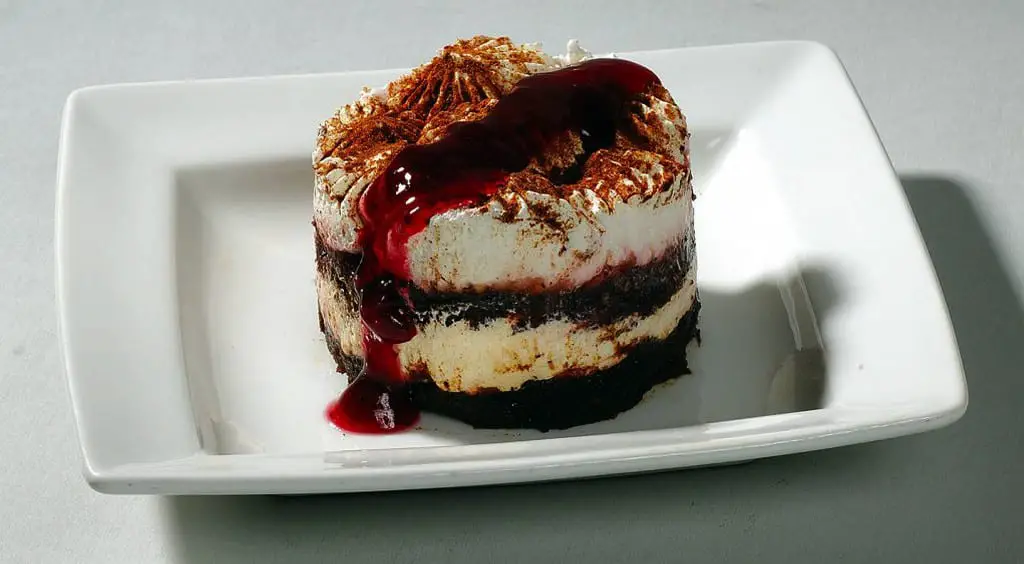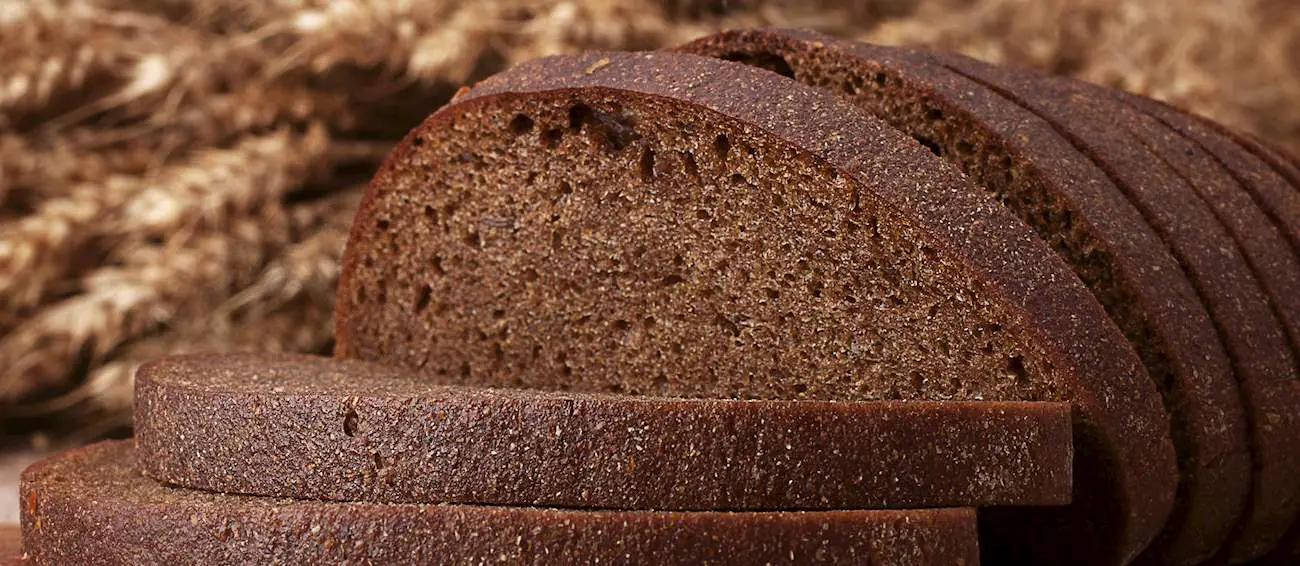Rye has been grown in Latvia for more than 1200 years and rye bread (rudzu maize or rupjmaize) has been a staple of Latvian cuisine for nearly as long. The reason why is simple: rye grows well in moist soil and can be planted in spring and fall and is thus exceptionally well adapted to Latvia’s wet climate, small growing plots, and short growing seasons. For Latvians, it has been important to survival through good times and bad.
With rye bread being a constant ingredient available to Latvian cooks for centuries, many uses have been found for it. Two of the most interesting are desserts and are the subject of this article: rupjmaizes kārtojums, a type of trifle, and rupjmaizes zupa, a sort of pudding. Both dishes are well known throughout the Baltics and Nordic countries but are also known there specifically as Latvian dishes.
Why They’re Called “Rupjmaizes Kārtojums” And “Rupjmaizes Zupa”
The Latvian word for rye bread, rupjmaize, comes from two roots: rupja meaning “coarse” and maize meaning “bread.” In practice it only refers to dark rye bread. This word can be compared to another Latvian word baltmaize, with balta meaning “white,” and which refers to white bread made of finely ground wheat flour.
To turn rupjmaize into an adjective, we add an “s,” getting rupjmaizes. Meanwhile, kārtojums literally means “arrangement” and is usually used to refer to layered dishes. It can also be seen in other constructions like “matu kārtojums” which means “hairdo,” with mats meaning “hair.”
Rupjmaizes zupa has a similar etymology in that rupjmaizes here still refers to the fact that the dish is made of rye bread. Zupa, as you might’ve already guessed, simply means soup. It’s thought that this word is borrowed from the German word suppe, which has deeper roots in Proto-Indo-European languages, specifically from the stem *seu- or *sū- which indicate “juice” or “moisture.”
The names of both dishes are sometimes shortened with that “rye” part dropped, leaving “maizes zupa” (bread soup) and “maizes kārtojums” (bread arrangement). Rather than making the “rye” optional, this is more a nod to obviousness that if you are talking about bread in Latvia, you are likely talking about dark Latvian rye.
There are other types of rye breads as well such as salinātā rudzu rupjmaize which is sweetened by scalding the rye flour with hot water and then adding a bit of sugar. In 2013, this variety of rye bread was registered as a Traditional Specialty Guarantee, a product designation protected by the European Union for products with special cultural and regional significance.
Rye bread in general is a source of cultural pride and a major aspect of Latvian culture. It’s included in the Latvian Cultural Canon as a Folk Tradition and was named the most Latvian word in 2020. Maizes diena (“Bread Day”) or Jēkaba diena (“Jacob’s Day”) is celebrated on the last Sunday of July every year around when the beginning of the rye and barley harvest. It’s on or around this day that the first loaves of bread from the harvest are baked and there are celebrations and feasts. Rye bread makes an appearance in folksongs and other festivals and also has superstitions associated with it. For example, if the bread is accidentally dropped on the ground, it must be immediately picked up and kissed.
When And How Eat Rupjmaizes Kārtojums And Rupjmaizes Zupa
During the mid to late Soviet era, as part of the postwar rebuilding process there was a general move to making many food products including rye bread in a more mechanized manner and on an industrial scale. As such traditional methods of cooking the dishes lapsed in the home and production. Since the mid 80s, there’s been a revitalization of these methods in some areas and during certain times, particularly for cultural preservation and holiday purposes. This is true of bread making and of making traditional foods. In this way, you can find rye bread baked from scratch at festivals, street markets, and bakeries and shops. This movement has erased the industrial and commercial production of both rupjmaizes kārtojums and rupjmaizes zupa, however and both are popular snacks available for purchase at most convenience and grocery stores.
Rupjmaizes kārtojums and zupa and can generally be eaten whenever one wishes, though especially at special dinners and parties. You will often find these served by “ethnographic houses” – which are banquet halls that dot the country that specialize in delivering traditional celebratory events with Latvian food, song, costumes, and dance. Birthdays, name days, weddings, and more are often celebrated at such places.
Both dishes are best eaten an hour or two or even later after preparation so the bread can fully soften and the flavors mix together. Both are usually served cold with whipped cream.
How To Correctly Cook Rupjmaizes Kārtojums And Rupjmaizes Zupa
Latvian rye bread is made from coarse rye flour with both malt and caraway seeds and cooked in a furnace or an oven. It’s a heavier bread with a thin crust, has a distinct deep flavor and nutty or even earthy taste.
Rye bread is a very versatile dish and known for having a long shelf life for bread. Latvian rye bread can last months without going bad. That said, fresh always tastes better and you can always dry out the older bread and use it for other recipes, such as for rupjmaizes kārtojums and rupjmaizes zupa.
To make rupjmaize, the key ingredient to any rye dish, you need a rye starter. If you don’t have access to this, you can simply mix rye flour with plain yoghurt (jogurts) until it becomes a porridge consistency and then you leave it covered in a warm place until it becomes sour. After this occurs, you can get to business of actually making the bread, that is adding the rest of the flour (milti), yeast (raugs), water (ūdens), caraway seeds (ķimeņu sēklas), sugar (cukurs), salt (sāls), and so on. Then the loaf is shaped into an elongated form. Typically the baker will then mark each loaf with a blessing-bearing “bread sign” (maizes zīme) or a marking on the top that has cultural and spiritual meaning. These signs vary depending on the ethnographic region. Traditionally rupjmaize is made in a wood fired oven, though today you might see it being made in more modern, electric ovens, depending on the baker.
Rupjmaizes kārtojums is made by grating rye bread and frying the resulting crumbs. They are then layered with a blackcurrant (upeņu), cranberry (dzērveņu), or lingonberry jam (brūkleņu ievārījums) and whipped cream (saldais krējums). Some recipes will use sweetened quark cheese, which will be higher in protein and lower in fat and sugar. Often the dish is topped with grated dark chocolate (tumšā šokolāde) and cinnamon (kanēlis) and served with fresh berries (svaigas ogas) or ice cream (saldējums).
Rupjmaizes zupa is made by first coarsely grating toasted or stale rye bread. Then you add just enough boiling water to make the mixture soft again. After that, sugar, cinnamon, cloves (krustnagliņas), and/or dried fruit (augļus) are added. From there you add water and/or cranberry juice and cook over low heat to mix the flavors and bring the “soup” to the right consistency. This dish is then usually served with whipped cream (or sweetened quark) and optionally topped with cranberries or another similarly tart fruit.
Just like any traditional food, there are many different variations of both of these dishes depending on individual preference, family practices, and ingredients available!
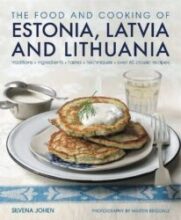 |
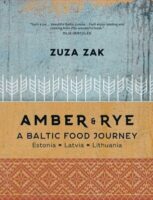 |
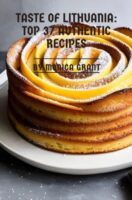 |
 |
For more on Baltic cooking keep exploring this site or try some of the great resources above!
Let’s Cook!
| Rupjmaizes kārtojums | Latvian Layered Rye Bread Trifle |
Sastāvdaļas:
Pagaravošana:
Labu apetīti! |
Ingredients:
Preparation:
Bon appetite! |
| Rupjmaizes zupa | Latvian Rye Bread Soup |
Sastāvdaļas:
Pasniegšanai:
Pagaravošana:
Lai labi garšo! |
Ingredients:
For serving:
Preparation: 1. Cut slices of rye bread into cubes. 2. Put these on a baking pan. Heat the oven to 180 °C and toast the pieces of bread. Rotate the pieces of bread from time to time. (You can use stale bread. It’s even better.) 3. When the pieces of bread are toasted, placed them in a pot and pour over with boiling water so that the bread is covered, put on a plate and keep for 25-30 minutes. 4. Add 4-5 tablespoons of jam and a pinch of cinnamon. 5. Add dried fruit rinsed with boiling water. Mix everything. 6. Put the pot on the stove and cook for around 25 minutes. If the bread soup becomes too thick, add a little more boiling water. Taste and if necessary, add more jam or cinnamon. 7. When the bread soup is ready, pour it into bowls and refrigerate. Beat the sweet cream with 2 tablespoons of sugar and 1 teaspoon of vanilla sugar. When the sweet cream is whipped, put it on top of the bread soup and serve. Enjoy! |
Our Favorite Rupjmaizes Videos
This video is a short tour of the process of making Latvian rye bread by the bakery Liepkalni.
An easy walk-through in English of how to make rupjmaizes kārtojums from the popular cooking YouTube channel AllasYummyFood.
This video is a nice, in-depth explanation in English of how to make rupjmaizes zupa with a slight personal twist.
You’ll Also Love

Latvian Holidays 2025: A Complete Guide
Latvian holidays are steeped in ancient pagan tradition. Most important are the winter and summer solstices. Connections with the ancient past are thought to be the most authentic connections with being Latvian. Other major holidays celebrate the hard-won independence and sovereignty of Latvia. Soviet influence, especially as compared to other former Soviet republics, is minimal, […]
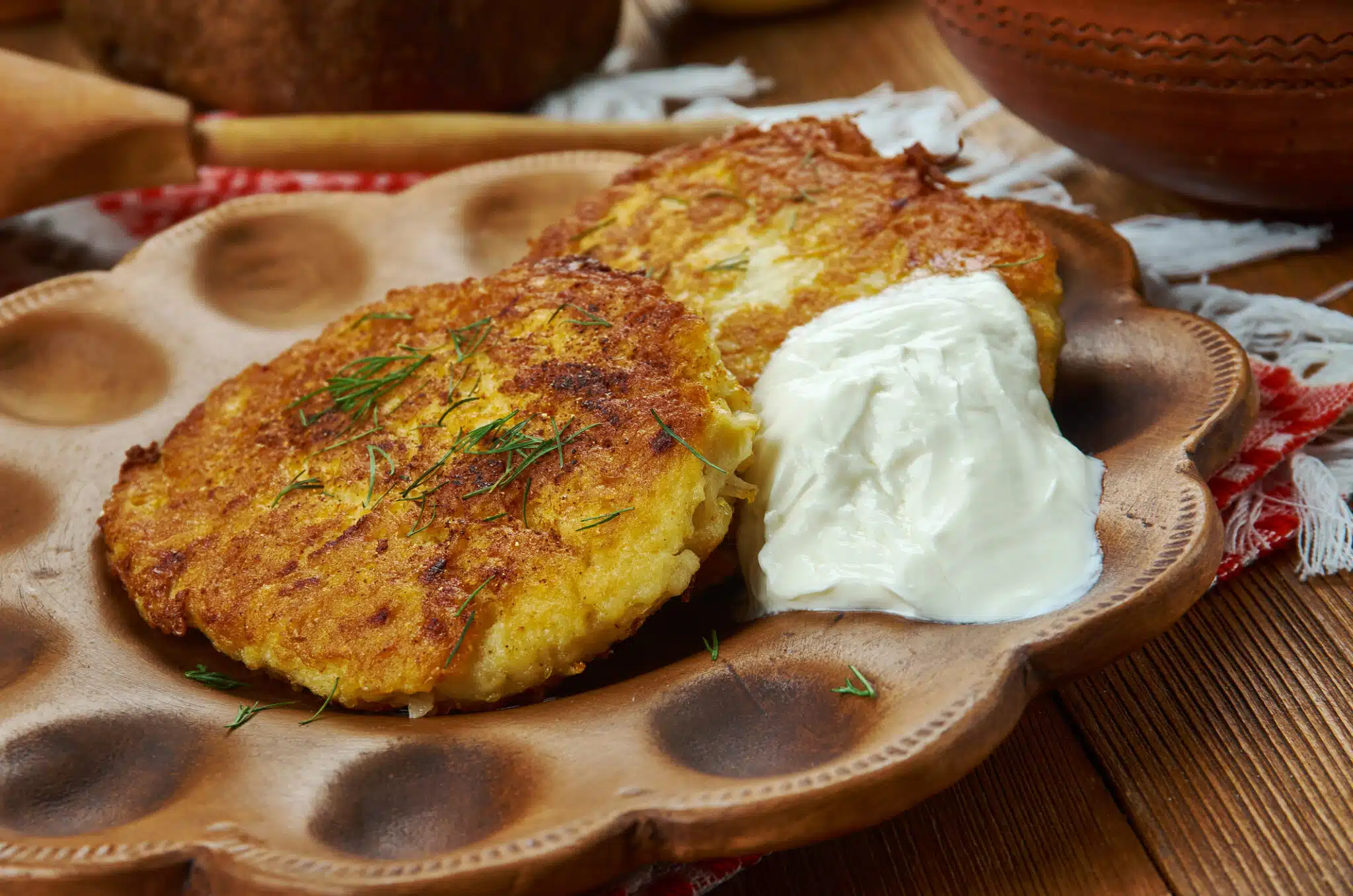
Draniki, Latkes, Kartupeļu Pankūkas: The Simple Deliciousness of Potato Pancakes
Potato pancakes dominate coffee shop menus in Riga, Latvia—and for good reason! Meticulously prepared using grated potatoes, eggs, and flour, these pancakes are crisped to a brilliant golden hue, reaching a level of perfection that rivals the shining sun itself. The mouthwatering allure of this delightful dish is recognized worldwide. Following their inception in Eastern […]

Olivier and Rasols Salads: Holiday Traditions With Fascinating Histories
Russia’s Olivier Salad (Салат «Оливье») and Latvia’s rasols are well-known staples of their respective cuisines and common additions to holiday tables. Today, the recipes for both are quite similar, with chopped vegetables, egg, and meat dressed with mayonnaise. Olivier is now eaten throughout the former USSR and has even become common as “Russian Salad” in […]

Latvian Rye Bread Desserts: Rupjmaizes Kārtojums and Rupjmaizes Zupa
Rye has been grown in Latvia for more than 1200 years and rye bread (rudzu maize or rupjmaize) has been a staple of Latvian cuisine for nearly as long. The reason why is simple: rye grows well in moist soil and can be planted in spring and fall and is thus exceptionally well adapted to […]
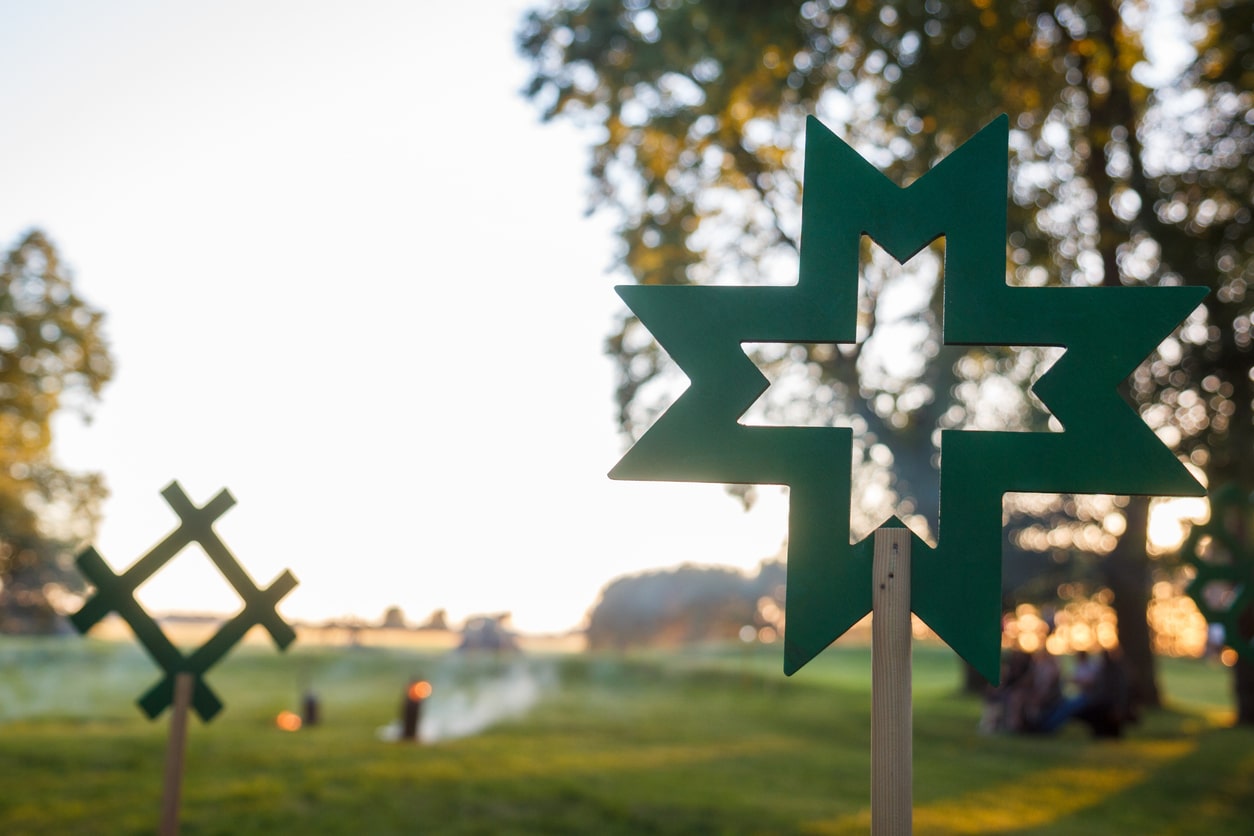
Latvian Identity: Understanding the Latvian National Narrative
This resource analyzes Latvian national identity through a selection of Latvian national heroes, pivotal events in Latvian history, geography in the Latvian national consciousness, and the role of religion, language, and ethnicity in the Latvian understanding of what it means to be Latvian. It will also briefly cover ethnic diversity in Latvia. The intent is […]

